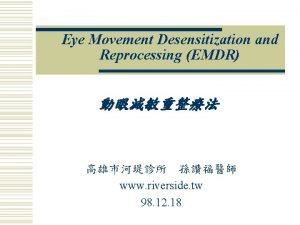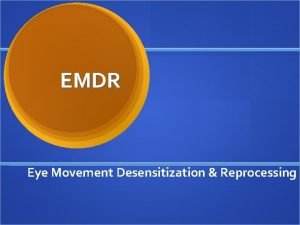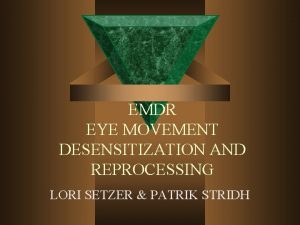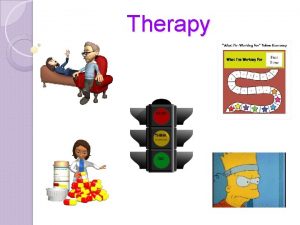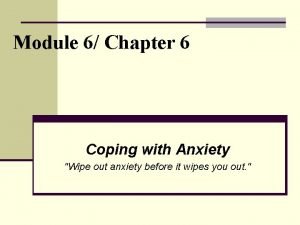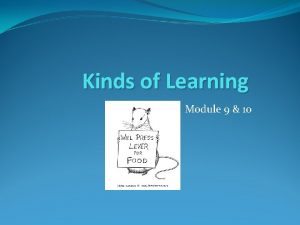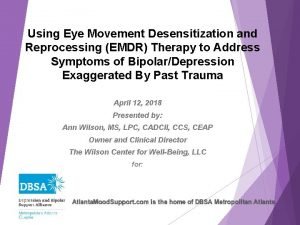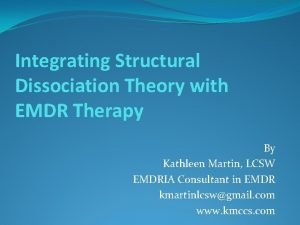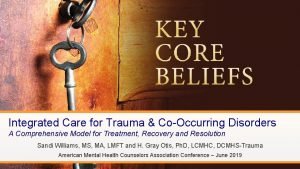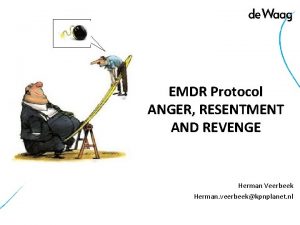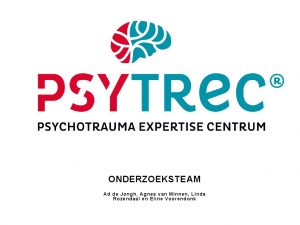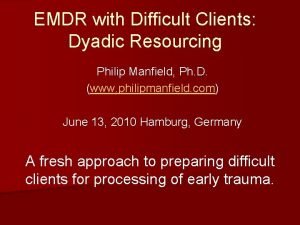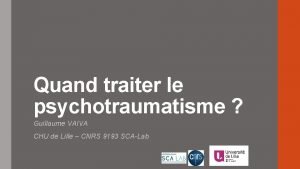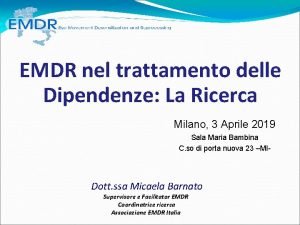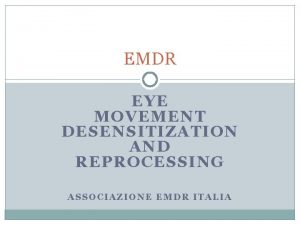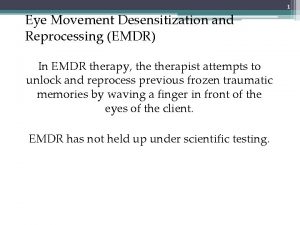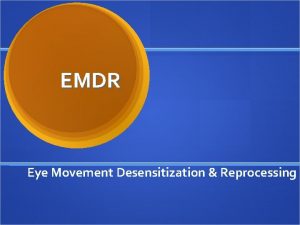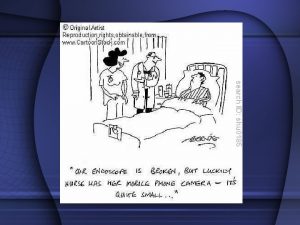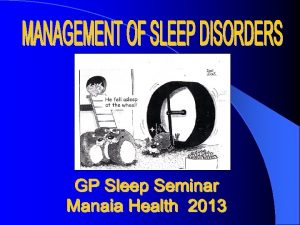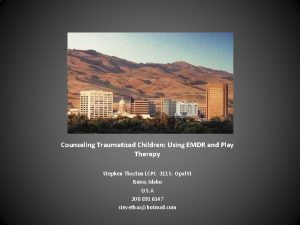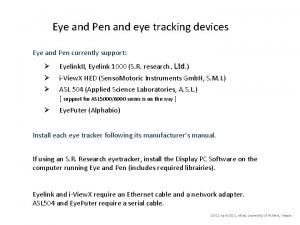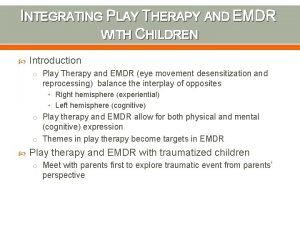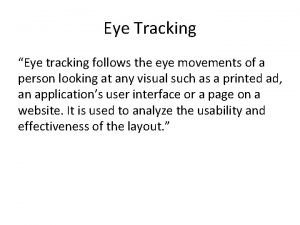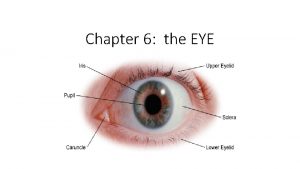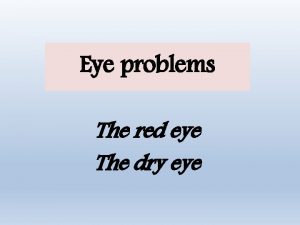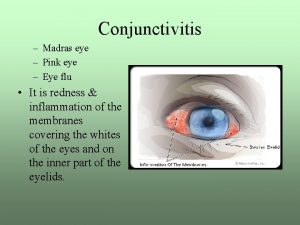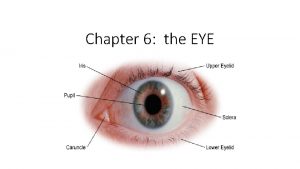Using Eye Movement Desensitization and Reprocessing EMDR Therapy
























- Slides: 24

Using Eye Movement Desensitization and Reprocessing (EMDR) Therapy to Address Symptoms of Bipolar/Depression Exaggerated By Past Trauma April 12, 2018 Presented by: Ann Wilson, MS, LPC, CADCII, CCS, CEAP Owner and Clinical Director The Wilson Center for Well-Being, LLC for:

What is EMDR? “Eye Movement Desensitization and Reprocessing (EMDR) is an integrative psychotherapy approach that has been extensively researched and proven effective for the treatment of trauma. EMDR is a set of standardized protocols that incorporates elements from many different treatment approaches. To date, EMDR therapy has helped millions of people of all ages relieve many types of psychological stress. ” (emdria. org/displaycommon. cfm? an=1&subarticlenbr=2) ◦ Video: How EMDR Works: https: //www. youtube. com/watch? v=h. Krf. H 43 srg 8

History & Overview of EMDR Francine Shapiro, Ph. D, founder Nearly 30 years of developing EMDR Psychotherapeutic approach vs. technique Basic EMDR protocol Advanced protocols developed (adapted for specific types of trauma: recent events, eating disorder, pain issue, working with children, traumatic grief, chronic childhood trauma/attachment issues, etc. )

Understanding Trauma and the Brain Adaptive Information Processing—Difficulty Integrating Traumatic or Disturbing Life Experiences Memory storage fragmented and state-dependent Targets past experiences, current triggers and possible future triggers (Flashbacks to barely noticeable intrusions) Triggers then initiate similar trauma reactions PTSD: persistent re-experiencing, arousal, and avoidance Normal brain processing is not completed, reprocessing is needed In comes EMDR (the desensitization to combat the avoidance so that reprocessing can occur)

• EMDR as a Trauma Uses the natural processing of the brain Treatment • Minimizes re-traumatization of the traumatized person • Avoidance versus processing (BLS) • Actually treats trauma at a biological brain level • Processing occurs at a heightened speed, not all details are discussed as in talk therapy • Three-pronged approach: past memory, current trauma reminders, and future anticipation of trauma reminders

Target Populations • • Empirically researched and validated treatment for trauma • Evidenced-based treatment approach for Post Traumatic Stress Disorder (PTSD) • Recommended by the VA, American Psychological Association, and American Psychiatric Association • For children and adults More and more research showing that it is effective for many mental health issues: Ex)Anxiety, OCD, Panic, Hoarding, Eating Disorders, Bipolar, Depression, Postpartum. However, more research is needed in these areas.

Is EMDR Effective? Research & Evidence Base EMDR is widely recognized as an acceptable and appropriate treatment for trauma A wide research base exists The research is composed of many different types of studies A comprehensive list of clinical trials can be found at: http: //emdria. site-ym. com/? page=EMDRResearch and http: //www. emdr. com/research-overview

Bipolar and EMDR • If stress is a part of your depression, EMDR Therapy has been proven helpful for stressful or traumatic events and the depression that goes along with them. It is well-established that though bipolar disorder may have genetic contributors, the condition is initially activated by stress. By “processing” these experiences through the EMDR therapy protocol, the negative memories, negative self-beliefs, emotions and physical sensations are desensitized. They gradually become less upsetting and feel less significant. Positive beliefs about yourself become stronger, through the EMDR processing. • Evidence suggests that PTSD is more prevalent among patients with Bipolar Disorder (16% vs. 8% in a lifetime) • Bipolar patients with PTSD tend to exhibit more bipolar symptoms and are at increased risk to disengage from treatment suggesting poorer outcomes. • Bipolar patients, due to mood swings, are prone to traumatic events which negatively impact the course of their disease. • Research has shown that stress induced bipolar depression responds positively to EMDR but more research is needed. From www. emdria. org

Bipolar and EMDR • Trauma Focused Cognitive Behavioral Therapy and EMDR are considered first-line treatments for PTSD. • Anti-depressant pharmacology treatment is often the second-line of therapy but often not an option for bipolar patients due to manic switch and adverse long term outcomes. From: “Eye Movement Desensitization and Reprocessing for Posttraumatic Stress Disorder in Bipolar Disorder” Daeyoung Oh*, Daeho Kim • Department of Psychiatry, Hanyang University Medical School, Seoul, Republic of Korea Published Journal Article: http: //psychiatryinvestigation. org/journal/view. php? d oi=10. 4306/pi. 2014. 11. 3. 340

Bipolar and EMDR Specific EMDR protocols available for bipolar patients include: • Mood stabilizing • Illness Awareness • Adherence to Treatment • Increasing Awareness of Early Symptoms to Avoid Relapse • De-Idealization of Manic Symptoms

Components of the Model • • • Phase 1: History taking & client selection Phase 2: Preparation Checklist Phase 3: Assessment Phases 4 -7 (Reprocessing Procedures): Desensitization; Installation; Body Scan; Closure Phase 8: Reevaluation

Phase 1: History taking & Client selection The focus of Phase 1 is to collect background information about the client ◦ Clinicians use their typical history or intake forms (i. e. Psychosocial Assessment); ◦ EMDR is explained and incorporated into the client’s treatment plan. Informed consent is obtained. The clinician must determine the client’s ability to engage in the EMDR process, as well as the client’s ability to cope with stressful situations It is common to focus on developing resources and coping skills before the EMDR process is started. Ex) Safe Space, Mindfulness Exercises, building support network, DBT History will include trauma history but less details are usually obtained compared to traditional talk therapy.

Phase 1: History taking & Client selection • The clinician will assess: • Single incident/single issue or symptom vs. • Multiple issues/symptoms • Strengths and Deficits • “Target” memories are explored

Phase 1: History taking & Client selection • Three-Pronged Protocol • • Past • What incidents are contributing to current problems? • What skills are needed? Present • • What distressing symptom(s) is the client experiencing now? Future • What does the client want to

Phase 1: History taking & Client selection • Clinical concerns • Client Stability • • Assess for presence of Dissociative Identify Disorder Acute Presentations • Substance Abuse; Suicide; Self Injury • Stabilization/Appropriate Coping Skills • Medical Considerations: • • Medications; eye pain, other body pain Time considerations • Is the client and therapist available for needed sessions?

Phase 1: History taking & Client selection Targeting Sequence Plan ◦ The clinician begins exploring dominant irrational beliefs and developing positive beliefs that will be installed during future sessions Dominant irrational beliefs about the self translate in to negative cognitions (NC) for example: I am a bad person I cannot trust anyone I am weak I deserve to die What the person prefers to believe about the self translates in to the positive cognition (PC) I am fine as I am I did the best I could I am adequate

Phase 2: Preparation Phase • This phase takes one to four sessions for most clients (for others with traumatized background or other diagnoses, it can take longer) • The therapist will be working on three main areas • • Establishing a therapeutic relationship of trust between the client and therapist • Psycho-education: Explain theory of EMDR, how it is done, and what the person can expect during and after treatment • Teach the client a variety of relaxation techniques for self soothing in the face of any emotional disturbance that may arise during or after a session When the client is ready, therapist works with client to identify the first target to be worked on (can be a current trigger or past memory)

Phase 2: Preparation Phase Resource Development: What does the person need to be able to face the terrifying experience? ◦ Think of a beloved friend or family member ◦ A place of safety ◦ A comforting memory or experience ◦ A special object ◦ A quality of courage, strength, compassion, confidence, love, etc. Using bilateral stimulation (slow movements) for relaxation Relaxation exercises & Self-soothing techniques

Phase 3: Assessment Identifying current state Activate memory with specific image Identify negative cognition or belief Create positive belief The emotions and sensations in the body

Phase 3: Assessment Select a target memory ◦ Image ◦ Grief, sadness, anger Physical sensation ◦ Clinician utilizes 1 -7 scale Emotions ◦ “I am worthy and worthwhile. ” Validity of PC (VOC) ◦ “I am worthless/inadequate” Positive Cognition (PC) ◦ “My mother telling me not to cry” Negative Cognition (NC) ◦ “My father died when I was 8 years old” Tightness in chest, can’t breathe, stomachache Subjective Units of Disturbance Scale (SUDS) ◦ Clinician utilizes 0 -10

Phases 4 -7 (Reprocessing Procedures): Desensitization; Installation; Body Scan; Closure Phase 4: Desensitization ◦ BLS is used to process the image, using the NC and SUDS ◦ This part can take most of the session or multiple sessions Phase 5: Installation ◦ Phase 6: Body Scan ◦ BLS is used to install the PC; the goal is to have a VOC of 7 BLS is used to process any physical sensations left in the body Phase 7: Closure ◦ It is important to debrief the client and advise that reprocessing may continue after the session ◦ Determine if containment or relaxation exercise is needed by client to tie up loose ends

Phase 8: Reevaluation • Once reprocessing of the original memory target is complete and client returns in the next session, disturbance related to the re-processed memory is once again assessed Why? Sometimes target was not completed or other material was triggered between sessions ◦ Therapist assesses current level of disturbance ◦ If client remains at a SUDS=0, resourcing or new target may be tackled ◦ If client shows some level of disturbance when the original target is brought up, reprocessing continues with current upsetting image and baseline Reevaluation occurs throughout course of therapy

EMDR Resources Getting Past Your Past by Francine Shapiro) The Body Keeps the Score by Bessel Van der Kolk, M. D. www. emdria. org and www. emdr. com offer therapist finding tools, research, additional details on EMDR www. youtube. com offers several musical videos for relaxation. Search “EMDR Music” and listen with earphones. http: //www. annwilsonlpc. com/resources. html to view tonight’s presentation “Personal Stories” video: https: //www. youtube. com/watch? v=Qi. ULmo. DQe 5 g

Questions?
 孫讚福醫師
孫讚福醫師 Psychodynamic vs psychoanalytic
Psychodynamic vs psychoanalytic Emdr therapy
Emdr therapy Emdr therapy
Emdr therapy Ann
Ann Disadvantages of dialyzer reuse
Disadvantages of dialyzer reuse Steps in systematic desensitization
Steps in systematic desensitization Problem focused coping examples
Problem focused coping examples Systematic desensitization example
Systematic desensitization example Systematic desensitization example
Systematic desensitization example Desensitization techniques
Desensitization techniques Worms eye view examples
Worms eye view examples Emdr congres
Emdr congres Emdr negative cognitions
Emdr negative cognitions Kathleen martin emdr
Kathleen martin emdr Emdr negative cognitions
Emdr negative cognitions Herman veerbeek
Herman veerbeek Linda rozendaal
Linda rozendaal Emdr videos manfield
Emdr videos manfield Guillaume vaiva
Guillaume vaiva Emdr
Emdr Emdr uk accreditation
Emdr uk accreditation Sandi richman emdr
Sandi richman emdr Psychodynamic and humanistic therapies have in common
Psychodynamic and humanistic therapies have in common Bioness bits cost
Bioness bits cost
